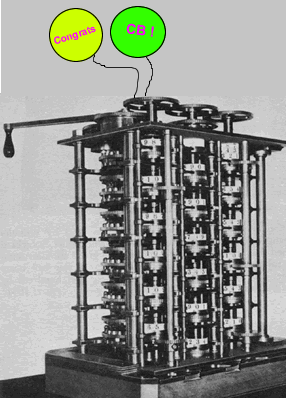

|
Charles Babbage—The Difference Engine
By the late 1820s, Charles Babbage had completed the first of phase of his Difference Engine, a machine consisting of hundreds of gears, capable of calculating polynomials.
For example, the machine could be set up to calculate squares:
- crank it once, you see "1" (which is 1 x 1)
- crank it again, you see "4" (because that is 2 x 2)
- crank it again, and you see "9" (for 3 x 3)
- crank it again, and you see "16" (equal to 4 x 4)
- and so on
This doesn't seem too impressive at first: however, bear in mind that you could keep going in this way up to 31-digit numbers, at which point the machine was, clearly, doing the computations faster and more accurately than a human could.
The Difference Engine made Babbage the toast of England. He even received government sponsorship for this impressive project.

(Note: The Difference Engine is also the title of a 1992 book by science fiction writers William Gibson and Bruce Sterling. The main premise of this book is, What if the computer had been invented 100 years earlier?)
![]()
![]()
These pages were written by Steven H. VanderLeest and Jeffrey Nyhoff and edited by Nancy Zylstra
©2005 Calvin University (formerly Calvin College), All Rights Reserved
If you encounter technical errors, contact computing@calvin.edu.